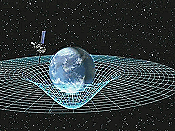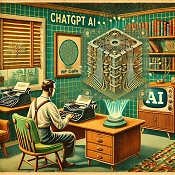Electronics & Technology
- See Full List of AI Topics -

Albert Einstein's
general theory of relativity, published in 1915, fundamentally reshaped the way
scientists understand gravity, space, and time. It extended his 1905 special theory
of relativity, which described how the laws of physics are consistent for all observers
in uniform motion and how light's speed is constant in a vacuum. However, the special
theory did not address accelerating reference frames or gravitational forces. Einstein's
general theory tackled these limitations by proposing that gravity is not a force
in the traditional sense, but rather a curvature of spacetime caused by mass and
energy. This profound insight would alter the course of 20th-century physics, influencing
cosmology, black hole theory, and the study of the universe's expansion.
Albert Einstein was born on March 14, 1879, in Ulm, Germany, and was raised in
Munich. He exhibited an early fascination with mathematics and physics, attending
the Polytechnic in Zurich and graduating in 1900. Following some early career difficulties,
he accepted a position at the Swiss Patent Office in Bern in 1902, which provided
him time to study physics independently. His curiosity about gravity and the fundamental
forces of the universe persisted throughout his years at the patent office. By 1909,
Einstein's academic reputation had grown enough for him to leave the patent office
and take on teaching roles in Zurich and Prague. In 1914, he moved to Berlin to
join the Prussian Academy of Sciences, an elite institution that offered him both
research freedom and a high-profile platform.
The inspiration for the general theory of relativity came from what Einstein
called his "happiest thought": the realization that an observer in free fall would
not feel gravity. This insight occurred around 1907 while Einstein was still working
on special relativity and conceptualized what would become the equivalence principle.
The equivalence principle asserts that there is no detectable difference between
acceleration and gravitational pull, making it possible to interpret gravity as
the effect of spacetime curvature. Over the following years, Einstein developed
his ideas further, attempting to generalize relativity beyond inertial frames. This
journey was arduous and required significant advancements in mathematics, especially
in the field of differential geometry, which he had to master with the help of mathematicians
such as Marcel Grossmann, a former university classmate, and David Hilbert, who
was one of the leading mathematicians of the time.
After several years of intensive work, Einstein presented the general theory
of relativity to the Prussian Academy in November 1915. His field equations, at
the heart of the theory, related the curvature of spacetime to the distribution
of mass and energy. The key equation, now known as the Einstein field equation,
is written as:

In this equation,
Gμν represents the curvature of spacetime,
Tμν represents the energy-momentum tensor (which
describes the distribution of matter and energy),
Λ
is the cosmological constant, G is the gravitational constant,
and 𝑐 c is the speed of light. The field equations are complex and non-linear,
making them difficult to solve, but they fundamentally describe how mass and energy
"tell" spacetime how to curve, while spacetime curvature "tells" objects how to
move.
One of the early tests of general relativity involved the orbit of Mercury. Newtonian
mechanics could not fully explain the planet's perihelion precession, a slow rotation
of Mercury's elliptical orbit around the Sun. Einstein's equations predicted an
additional amount of precession that matched observed data precisely. This success
was a triumph for Einstein, providing one of the first pieces of observational evidence
for his theory. The theory's most famous early verification came in 1919, during
a solar eclipse expedition led by British astronomer Sir Arthur Eddington. Eddington
observed starlight bending around the Sun, a phenomenon predicted by general relativity
due to spacetime distortion near massive objects. When Eddington's results were
announced, they made Einstein an international celebrity, as they confirmed his
prediction that light paths curve in a gravitational field.
Einstein's general relativity also laid the theoretical foundation for black
holes. In 1916, physicist Karl Schwarzschild found a solution to Einstein's equations
that described a region of space where gravity is so intense that not even light
can escape. This led to the concept of the Schwarzschild radius, the critical radius
at which a star's mass would collapse into a black hole. Although Einstein initially
doubted that black holes could form in nature, later observations and theoretical
work confirmed their existence, establishing black holes as one of the most dramatic
predictions of general relativity.
In addition to black holes, general relativity has had profound implications
for cosmology. Einstein originally included a term called the cosmological constant
in his field equations, as he believed the universe was static. When Edwin Hubble
discovered that the universe was expanding in 1929, Einstein famously retracted
the cosmological constant, calling it his "biggest blunder." Ironically, the cosmological
constant was later revived to explain dark energy, the force thought to drive the
accelerating expansion of the universe.
Einstein's work on general relativity was groundbreaking, yet he faced professional
obstacles. Although he had supporters, particularly in Europe, there were also critics
who challenged his ideas. Some detractors, including physicists such as Philipp
Lenard and Johannes Stark, were openly hostile to Einstein, often motivated by personal
biases and, in some cases, anti-Semitic views. Stark and Lenard were part of a movement
that dismissed Einstein's theories as "Jewish science" and sought to promote an
alternative "German physics." Despite these challenges, Einstein's reputation grew,
and he received the Nobel Prize in Physics in 1921, though it was awarded for his
explanation of the photoelectric effect rather than relativity.
Einstein's personal life was complex. He married Mileva Marić in 1903, and the
couple had two sons, Hans Albert and Eduard, though they also had a daughter, Lieserl,
who likely died in infancy. Einstein and Mileva divorced in 1919, after which he
married his cousin Elsa Löwenthal, who supported him during his rise to fame. His
fame, however, strained their relationship as well, and Elsa became one of his few
close confidants as he continued to work on relativity and explore its implications.
In 1933, Einstein left Germany due to the rise of the Nazi regime and took a
position at the Institute for Advanced Study in Princeton, New Jersey. He would
live in Princeton for the rest of his life, focusing much of his later work on unified
field theory, an attempt to reconcile general relativity with quantum mechanics.
Although he was never able to complete this work, his contributions to relativity
and his insights into the nature of gravity, space, and time continued to inspire
future generations of physicists.
The general theory of relativity has continued to be validated by multiple lines
of evidence. Beyond Mercury's orbit and Eddington's eclipse observations, the theory
has been confirmed through the detection of gravitational waves, ripples in spacetime
caused by colliding massive objects like black holes and neutron stars. First observed
in 2015 by the LIGO experiment, gravitational waves matched Einstein's predictions
and provided direct evidence for another one of his theory's remarkable implications.
Today, general relativity is a cornerstone of modern physics, and its applications
extend to technologies like the Global Positioning System (GPS), which requires
relativistic corrections for accurate navigation.
Einstein's general theory of relativity thus stands as one of the towering achievements
in the history of science. It redefined our understanding of gravity not as a force
but as a distortion of spacetime itself, revealing the universe as an interconnected
fabric shaped by mass and energy. The theory transformed physics, opened up new
areas of research, and continues to inform our study of the cosmos more than a century
after its inception.
 This content was generated by the ChatGPT
artificial intelligence (AI) engine. Some review was performed to help detect and
correct any inaccuracies; however, you are encouraged to verify the information
yourself if it will be used for critical applications. In some cases, multiple solicitations
to ChatGPT were used to assimilate final content. Images and external hyperlinks
have also been added occasionally. Courts have ruled that AI-generated content is
not subject to copyright restrictions, but since I modify them, everything here
is protected by RF Cafe copyright. Your use of this data implies an agreement to
hold totally harmless Kirt Blattenberger, RF Cafe, and any and all of its assigns.
Thank you. Here are the major categories. This content was generated by the ChatGPT
artificial intelligence (AI) engine. Some review was performed to help detect and
correct any inaccuracies; however, you are encouraged to verify the information
yourself if it will be used for critical applications. In some cases, multiple solicitations
to ChatGPT were used to assimilate final content. Images and external hyperlinks
have also been added occasionally. Courts have ruled that AI-generated content is
not subject to copyright restrictions, but since I modify them, everything here
is protected by RF Cafe copyright. Your use of this data implies an agreement to
hold totally harmless Kirt Blattenberger, RF Cafe, and any and all of its assigns.
Thank you. Here are the major categories.
Electronics & High Tech
Companies | Electronics &
Tech Publications | Electronics &
Tech Pioneers | Electronics &
Tech Principles |
Tech Standards
Groups & Industry Associations |
Societal Influences on Technology
|











